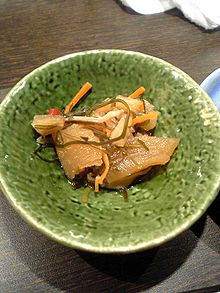Matsumaezuke

Matsumaezuke (松前漬け) is a pickled dish of dried squid and kelp, native to Hokkaidō, Japan, named in reference to the Matsumae clan which once governed the region, then known as Ezo.
It is made from dried and preserved seafood products from Hokkaidō. Surume (dried squid) and konbu are cut into thin strips with scissors, Kazunoko (herring roe) are broken up into small bits, with other ingredients added depending on recipe. The ingredients are cured in sweet soy sauce, or marinade of sake, soy sauce and mirin, for several days.
History
There are conflicting claims as to the evolution of the dish.
According to the publication from the ex-MITI governmental research body Tsūsan kikaku chōsakai (1987), matsumaezuke developed naturally within the Matsumae domain in Ezo (Ainu country), among the immigrating wajin populace (non-native mainland Japanese), using dried squid (surume) and kombu kelp, which were the locally abundant and trade commodities. It can probably be dated to around the Kansei era (1789–1801),Template:Efn2 when kitamae ships began to bring readily available supplies of soy sauce, etc., into the area.[1] The name "Matsumae zuke" did not originate then, and the dish was simply called kobuika (こぶいか, 'kelp-squid') or ika no shōyu zuke (いかの醤油漬, 'squid-soy sauce-pickle'). The "Matsumaezuke" nickname was coined in the Shōwa era, and though originally a squid and kelp only preserve, a type adding kazunoko (herring roe) began to circulate around Showa 3 (1929).[1]
Alternately, Yamagata-ya of Hakodate<--Hakodate is on the east coast and has more of association with direct Bakufu control than Matsumae clan headquartered on the west coast.--> which lays claim to ganso (元祖, 'the original') matsumae zuke explains that this was something "made at home in the southern Hokkaido region, as a salted pickle overnight", but the company founder changed it to a soy sauce pickling recipe and marketed as a product in Showa 13 (1938).[2] The item would eventually gain name recognition nationwide.
In the 1950s, Japan's herring fisheries collapsed, and with the scarcity, and by the mid 1960s and thereafter, kazunoko became more of an "expensive delicacy" item nicknamed "yellow diamond",[3][4] yet the item continues to be used.
As for the naming, it has been observed that the Hokkaido produce which is ma-kombu (sweet kelp) went by the nickname Matsumae kombu (松前昆布)[5] (or simply Matsumae (まつまえ)[6]) and consequently this and other dishes which used kelp often had "Matsumae~" prefixed upon its name (e.g. Matsumaezushi, Matumaeni, Matsumaemushi, Matsumaemaki).[6]
Recipe
A soy sauce on the sweet-side,[6] or a marinade blending soy sauce with (sweet) mirin are said to be used.[7]
Below follows a home-cooking recipe published in newspaper:[8]
- The kazunoko must be soaked in dilute saltwater beforehand, overnight.
- The dried squid and kombu should be cleaned by sponging off any debris using wet cloth (paper towel dampened with sake), then cut into fine ribbons using [scissors|kitchen scissors]]. The kazunoko are broken up into bits before adding. If carrots are used they should be julienned.
- Moisten and soften the cut squid, and blend with other ingredients in a marinade made from sake, soy sauce, and mirin heated to boil and cooled off.
- Keep refrigerated, stirring several times per day. Ready to serve after about 3 days.
Although use of carrots[8] is not universal, some dictionary references list carrot or[9] or daikon radish. {{Refn|Okuyma lists"kelp, dried squid, daikon, kazunoko, yuzu peel" as an ingredient.[7] A tai (sea bream, in sashimi form) is sometimes blended.[6]。
In addition to the flavor and texture, the kombu adds a slimy viscosity considered desirable and healthy, and blending a different species of kelp known as gagome is recommended to achieve it.[8] A great side to go with alcohol.[8]
See also
- chinmi
- ikaninjin - Squid and carrots. Alternat theory holds that this was the original recipe that later became matsumaezuke
- Namasu (Food) - kōhaku namasu (紅白なます), a carrots and daikon osechi
References
- Citations
- ^ a b Tsūsan (MITI) Kikaku chōsakai, ed. (1987). 日本の地域産業: 特産品編. Ministry of Trade and Industry, MITI. p. 10.
- ^ In: Buka Kikaku, Ltd., "Prizes announced for the Bessatsu bunshun magazine" Bessatsu bunshun kakari happyō shōhin 別冊文春係発表賞品, PR section. "松前漬"+"醤油" "(Kabu[shikikaisha]) Yamagata-ya 'Ganso Matsumaezuke' <Hakodate shi>" (株)山形屋「元祖・松前漬」<函館市>. Bessatsu Bungei shunjū 別冊文藝春秋 (147). 1979.
- ^ Mackovjak, James (2022). "Chapter 9. Genesis and Management of Alaska's Ro-Herring Fishery". Alaska Herring History: The Story of Alaska’s Herring Fisheries and Industry. University of Alaska Press. pp. 143–144. ISBN 9781646423439.
- ^ NIRA (1990). 食文化と地域社会. National Institute for Research Advancement. p. 490. ISBN 9781646423439. (in Japanese)
- ^ Okuyama (1984) s.v. "Kombu コンブ", p. 171
- ^ a b c d Yoshida, Kanehiko [in Japanese], ed. (1996). "Matsumaezuki" まつまえづけ 松前漬. Ishokjū gogen jiten 衣食住語源辞典. Tokyodo shuppan. p. 300. ISBN 9784490104349.
- ^ a b Okuyama (1984) s.v. "Matsumaezuke 松前漬", p. 378
- ^ a b c d Hayami, Hiroki (2014-12-30). "Nebaneba ga kenkō no kagi: kazunoko tappuri no matsumaezuke" ネバネバが健康の鍵 数の子たっぷりの松前漬け [Sliminess is key to health: Matsumezuke with lots of kazunoko]. Sankei Shimbun: 41–46.
- ^ Shinmura, Izuru, ed. (1998). "Matsumaezuke" まつまえづけ【松前漬】. 広辞苑 (5 ed.). 岩波書店. p. 2518. ISBN 9784000801119.
- Bibliography
- Okuyama, Masurō, ed. (1984). "Kazunoko" 数の子. Mikaku jiten 数の子味覚辞典. Tokyodo Shuppan.
